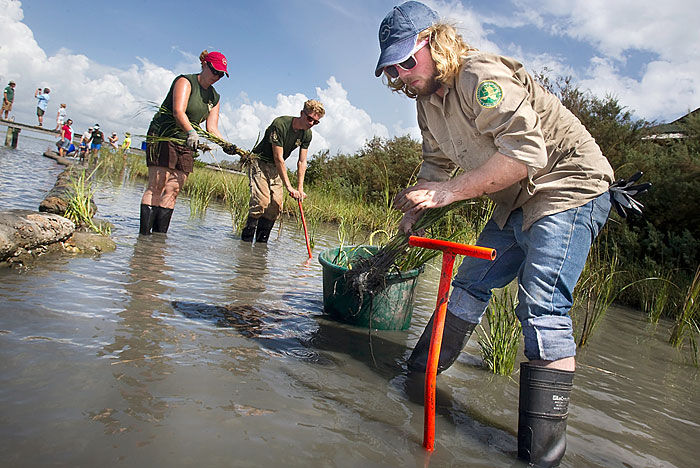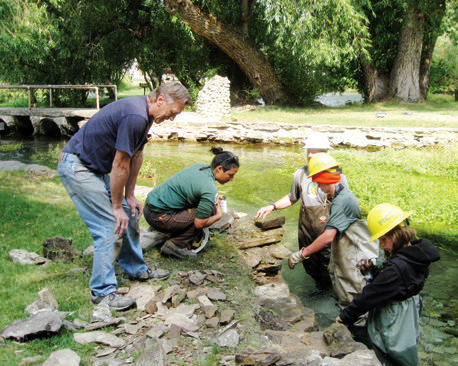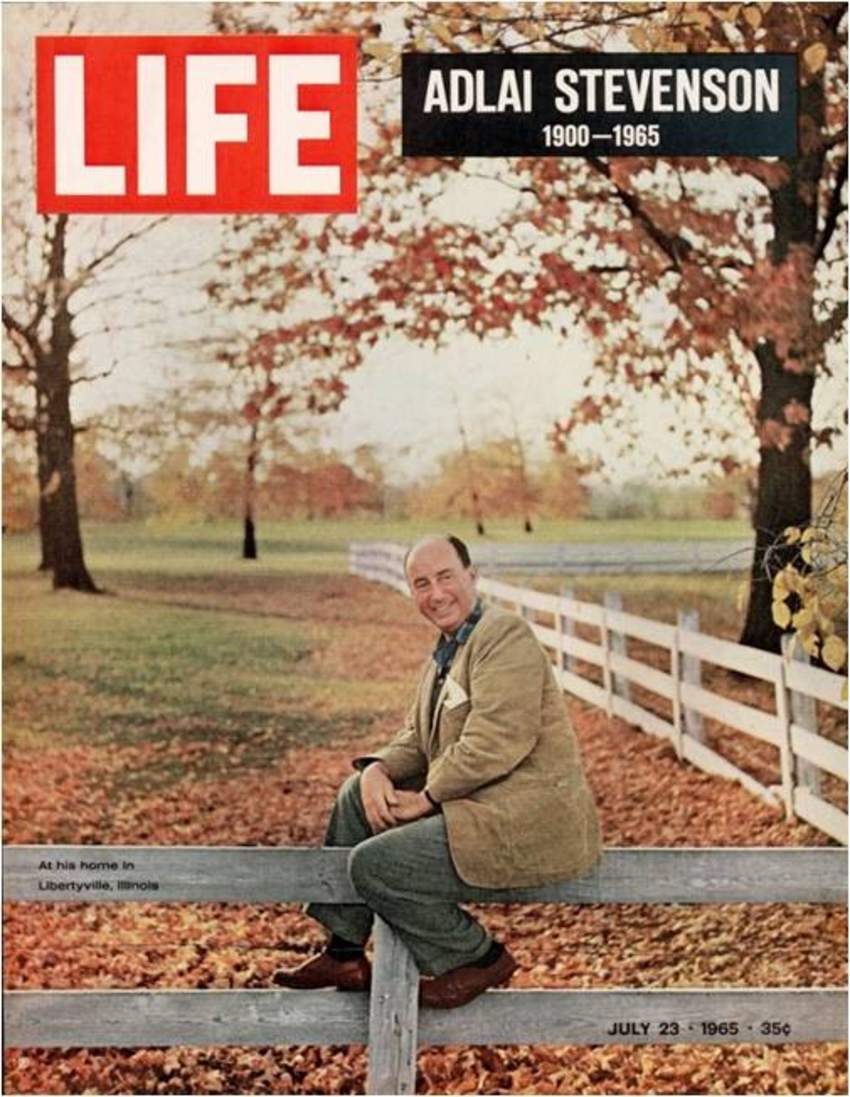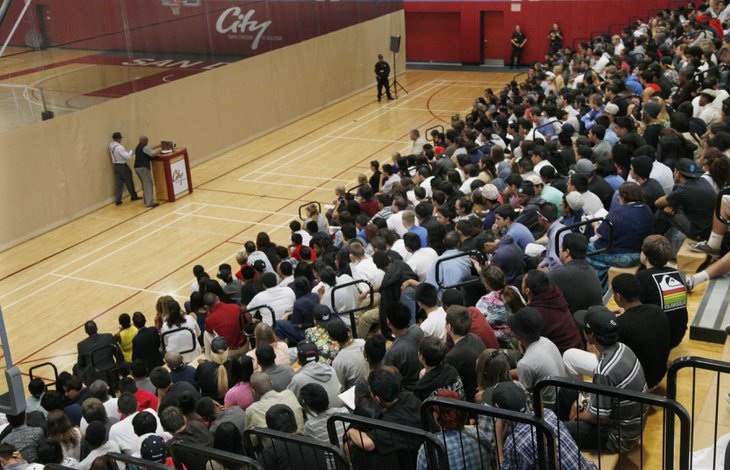Gulf of Mexico Foundation Works with Texas Conservation Corps to Train Youth, Plant Marsh Grass



This article was originally published by the Lewistown News-Argus.
 |
| The Montana Conservation Corps crew working on the fish hatchery make-over includes (from left) Timothy Gillispie, Helena; Eric Barr, MCC co-leader, Florida; Taggert Street, Helena; Sharanne Dement, Great Falls; Logan Callerg, Great Falls; Albert Leavell, MCC leader, Maryland; and Amanda Knorr, Helena. |
Having MCC do this work is fitting, Gies said, as it was the Civilian Conservation Corps that constructed the park in the first place.
Most of the park facilities at the Big Springs Trout Hatchery southeast of Lewistown were built by the Civilian Conservation Corps in about 1936, almost eighty years ago.
The CCC was a public work relief program that operated from 1933 to 1942 in the United States for unemployed, unmarried men from relief families, ages 18–25. Robert Fechner was the head of the agency. The program was a major part of President Franklin D. Roosevelt’s New Deal, and provided unskilled manual labor jobs related to the conservation and development of natural resources in rural lands owned by federal, state and local governments.
Now, almost eight decades later, the Montana Conservation Corps is doing repair and renovation work at the fish hatchery park. The Montana Conservation Corps grew out of stories of men joining and serving in the Civilian Conservation Corps, stories that can be heard at coffee counters across Montana in places like the Empire Café. Tales of the accomplishments of the CCC to improve the landscape and the spirits of the young people who joined are numerous, and verging on mythical, in the best tradition of Montana.
This week, MCC workers are busy repairing the facilities built by the CCC. These MCC workers include five Montana high school students and two supervisors in their twenties. The supervisors work right along with the kids.
In two days the crew has accomplished much of the repair of rock work in the big pool, building trails and pulling weeds. They have two more days of work left. Local master stone mason Jimmy Plovanic has been right along side of this crew, showing them how to do the repair and renovation work on the stone walls. These walls are simply stacked stone, but of course, stacked in an aesthetic and lasting way. Jimmy has made a great contribution in sharing his expertise.
The project leader on the park renovation is Eric VanderBeek. Eric has been a strong leader, including working to obtain $14,000 in grant money for the project. Locals Brad McCardle, Lewistown trails manager, Clay Dunlap, retired educator, and Clint Loomis, retired educator and artist, have also worked hard on this project. All have spent countless hours on planning and implementing the project. Much credit on this project goes to Paul Pavlak a Lewistown resident who started the ball rolling on this park renovation.
Karl Gies is a member of the Big Spring Creek Watershed Association.

Local teens working with Youth Conservation Corps restored the white fence Adlai Stevenson II sat on for this historic photo shoot.
Originally published in the Lake County News-Sun
By Linda Blaser
Work to restore the historic home of Adlai Stevenson II surged ahead this summer through the blood, sweat — and possibly tears — of a Youth Conservation Corps (YCC) crew.
The teenagers installed a 216-foot length of white slatted fencing, including sinking 27 8-foot-long fence posts, attaching three 1-by-14-foot slats per section and painting the entire fence white.
“It was quite a job,” YCC Manager Luke Bowman said.
The teens’ combined effort brings back an important historic element of the property, which is poised to receive a National Historic Landmark plaque at a special ceremony on Oct. 12. The house is located at 25200 N. St. Mary’s Road in Mettawa.
“We replicated the original fence in order to restore the look of the property to the way it was when (Stevenson) lived there,” said Katherine Hamilton-Smith, director of cultural resources at the Lake County Forest Preserves.
In fact, a famous photo of Stevenson sitting on the original fence graced the cover of LIFE magazine in 1965, after he died.
The YCC crew of three boys and three girls, plus crew leader and assistant crew leader, also spent several weeks clearing out invasive plants and trees that grew around a large oak Stevenson often stood beside to view the river.
“We made a lot of headway,” Bowman said of the clearing project.
Removing the fast-growing maples from around the slow-growing oak was essential to maintaining the historic tree and opening up the canopy so the oak will get the sunlight it needs.
It is the second year a YCC crew worked on clearing out the small-diameter sugar maples, buckthorn and other invasives that grew beneath the historic oak.
“This year we made it all the way to the river,” Bowman said of the clearing. “Now we’re working both directions to make the view wider.”
Work on the historic Stevenson home — particularly the fence — was one of the top priorities for the 2014 YCC summer program.
“I was willing to set the whole summer aside to get the fence right,” Bowman said.
A total of 36 teenagers from across Lake County spent eight weeks this summer working on restoration and construction projects to improve forest preserves throughout Lake County. For the past 15 years, YCC has partnered with the Lake County Forest Preserves to provide summer employment for high school students and to teach them valuable life skills.
“We’re working extra hard right now to maintain the property and have it look wonderful,” Hamilton-Smith said of the Stevenson home, which houses the Adlai Stevenson Center on Democracy.
The National Historic Landmark plaque presentation this fall will bring together a number of dignitaries, elected officials and other special guests to mark receipt of the prestigious honor.
“National Historic Landmark designation is a big deal,” Hamilton-Smith said. “This won’t happen again (in Lake County) any time soon.”
The Stevenson house is the second Lake County Forest Preserve District property to receive the designation — the first was a portion of the Fort Sheridan Historic District — and it is the first 20th-century Illinois politician’s home deemed a national landmark.

More than 800 youth offenders attended the sixth annual Passport to Life event held on the San Diego City College campus. Speakers from the juvenile justice system spoke and attendees were able to participate in workshops and resource exhibits from literacy to job preparedness.— Peggy Peattie, UT-San Diego.
Taken from UT-San Diego
By Dana Littlefield
SAN DIEGO — Like so many people who ended up addicted to drugs, Anakaren Ruano spent a lot of time chasing that first big high.
She started smoking marijuana and drinking alcohol when she was a high school freshman, and later started using ecstasy. Then, after her first stint at a rehabilitation facility at age 15, she tried methamphetamine.
“I felt like Wonder Woman,” said Ruano, now 19, giving a keynote address Friday to a large group of young people who’d had contact with the juvenile justice system. “It’s because of that feeling that people become addicted…
“To me, meth equaled me having fun.”
But it wasn’t long before the fun ran out. On one particularly gruesome occasion, Ruano found herself vomiting blood after mixing methamphetamine and cocaine. She said she was “locked up” nine times.
“Nothing was enough,” she said.
It was a sentiment — an attitude, maybe — that other teens and young adults in the room could probably relate to. Hundreds packed the bleachers in a San Diego City College gymnasium for the sixth annual Passport to Life Career and Education Expo, held to help youngsters who either are or had been on probation get tools they need to be productive, law-abiding adults.
“We’re not trying to scare you straight,” Chief Probation Officer Mack Jenkins told the crowd. “We’re trying to help you make better decisions.”
The event included workshops on such topics as pursuing education after high school, landing a job and gaining financial literacy. Several local organizations participated in the event, including the San Diego Superior Court, County Office of Education and the District Attorney’s and Public Defender’s offices.
“The message is to show these kids that the mistakes they’ve made in the past don’t have to define their future,” said Juvenile Court Judge Carolyn Caietti, who came up with the idea for Passport to Life one day while driving to work.
Eliseo Nuñez, 27, gave the second keynote address Friday morning. He admitted he didn’t like speaking in front of crowds, but he looked comfortable dressed in a button-down shirt, slacks and suspenders, his tattoos peeking from beneath his collar and a fedora perched on his head.
“I was that young man that was posted on the block 24/7,” the now ex-gang member from Oceanside said.
He talked about doing drugs at age 13 with his own father and getting locked up at 16. And he talked about being sent to state and federal prison. Then came the day when he realized how much life he was missing while he was behind bars. He saw that his own father had given up drug use in the years before he died of cancer.
In March 2012, Nuñez got clean, too. He finished high school, enrolled in college, and this year he received a national leadership award for his work with the Urban Corps of San Diego County, which teaches and counsels at-risk youth.
“I’m able to give back what was so freely given to me,” he said.
Ruano also welcomed the chance to give back. After years of drug abuse, including an alcohol-poisoning incident that almost ended her life, she has been sober for nearly two years. She went back to high school and graduated last year with her class.
“It was the best feeling of my life,” she said of walking across the graduation stage in cap and gown. “No drug had ever given me that kind of high.”
The day after graduation, her probation term ended. She recently completed her first year at MiraCosta College with a 3.5 GPA.
“You’re looking at a soul that’s not even supposed to be here, but I am,” Ruano said, adding that she’s not much older than many of those in the crowd.
“I got clean when I was 17 and I just want you guys to know that you can do it, too,” she said. “And you don’t have to hurt everyone in your way. You don’t have to hurt yourself and you don’t have to end up that person that’s six feet under because you never got it through your head to change.”

Article appears in LACC Newsletter.
It’s been a busy summer for RACLA!
From Dodger Games to sold-out events at the Rose Bowl (including LA Galaxy vs Manchester United soccer match and the highly anticipated Beyonce & Jay-Z Concert), our corpsmembers have easily collected well over 150,000 CRV beverage containers this season alone. Be sure to pitch in and recycle your bottles & cans at these events!
For the past 12 years, LA Corps’ Recycling Across Los Angeles (RACLA) program has provided a valuable and important service in the collection of recyclables in LA County. RACLA is a community collection program certified by CalRecycle (SP#0315).
RACLA recycling operations are currently housed at our 3,000-square-foot facility located in North East Los Angeles. We service 130 accounts, including LAUSD schools, businesses (Los Angeles Convention Center, CBS), entertainment venues (Pasadena’s Rose Bowl, AEG’s STAPLES, LA Dodger Stadium, and LA Convention Center), and public parks. In FY 12-13 alone, RACLA recycled more than 376 tons of cans and bottles which is approximately 3,731,989 beverage containers. Additionally, the program recycled over 206 tons of mixed paper and cardboard.

Colin MacDonald, a ’99 alum of EarthCorps, owns a private consulting firm with Steven Humphreys. Restoration Logistics takes a private approach to the environmental restoration work that EarthCorps and other nonprofits complete. The business works to bridge the gap between the science of ecology and the restoration projects taking place on the ground in the Puget Sound region. Working on both the consulting and contracting sides of ecological restoration, Restoration Logistics designs plans to improve and maintain natural habitats.

Aisha Dorn, an alum and graduate of Civic Works Community Lot program and B’more Green Environmental Certification program, now owns her own environmental management business, Lifeline Environmental, with her husband. Before starting her own business Aisha worked with a temp agency just one week after she completed her training. At her new job she met her husband Marc, who was injured at a worksite due to unsafe practices. Safety is important to Aisha and she felt that she could enter the industry on her own, making the jobs safe, correct, and efficient. It was this passion that led her and Marc to start Lifeline Environmental and since its creation they have seen much success. Many of her clients are nonprofits, including Civic Works where Lifeline was hired to help with the Clifton Mansion renovation process. Says Aisha, “it’s just such a strong network to be a part of.”


Revan Qajar, a graduate and former staff member of Urban Corps San Diego, started his own photography studio in El Cajon! His business, San Diego Stars Photography, provides professional photography and cinematography packages for all occasions.


Christy Jensen, an alum of Utah Conservation Corps, started her own craft kombucha brewery (lightly fermented tea with probiotic qualities) in Salt Lake City. Her business, Mamachari Kombucha, has gotten off to a great start, being sold in local restaurants and farmers’ markets. She has even found the need to expand and move production to a larger space! “Mamachari” means “mother’s bicycle” in Japanese, which reflects Christy’s love of bikes. Aside from her business, Christy also started a Womyn’s Wrench Night where women can bring their bikes and learn how to fix them.

Domenic Santangelo, a longtime staff member of the California Conservation Corps, retired in December 2013 after holding the role of Center Director for the CCC’s flagship residential camp in San Luis Obispo, California for 17 years. You can read a story about his 35 years with the program here. Instead of relaxing in his newly retired state, Domenic decided to start a business to further give back to the service and conservation corps!
His business, onthegrade, offers high-quality and uniquely artistic Corps accessories. Their mission is to service Corps with their marketing product ideas, offer everyday useful products, and recognize the awesome accomplishments of their Corpsmembers and staff.
A special way to give back to America’s Youth Corps is through their Giving Back program. This program donates cash up to 5% for qualified products non-profit Corps and/or their Foundations sell through the store. There is absolutely no risk to the Foundation/Corps recipient, with onethegrade willing to pay all manufacturing costs. Currently California Conservation Corps Foundation has partnered with onthegrade, selling “SEQUOIA” belt buckles to benefit CCC.
This is a great opportunity for Corps to generate revenue and create custom products (belt buckles, bracelets, lapel pins, and more!) to sell. If you are interested contact onthegrade for more details about the Giving Back program. Take advantage of this great opportunity to market and support your Corps! It’s inspiring to see people like Domenic Santangelo dedicate not only 35 years but also his retirement to the service and conservation corps. Thank you for your time as a staff member and we hope this business is successful!

Article, written by Victoria Hill, appears in Q2 News. Published July 30, 2014.
CROW AGENCY – Settled below Last Stand Hill at the Little Bighorn Battlefield National Monument, headstones mark the graves of more than 5,000 veterans and their loved ones.
A major headstone preservation project is underway at Custer National Cemetery after decades of natural wear and tear.
“They go through periods of freeze and thaw that deteriorate their condition,” explained Christopher Ziegler, chief of resource management at Little Bighorn Battlefield National Monument. “They sink, they settle, they get stained heavily.”
It’s all part of a new project by the National Trust for Historic Preservation called HOPE, or the Hands-on-Preservation-Experience.
The battlefield is one of the first national parks to participate.
“It’s very hard work here in the sun,” Ziegler said. “The headstones weigh around 150 pounds a piece and many of them are stuck in the ground really good and require lots of cleaning.”
It takes one hour to get one headstone dug up, cleaned, settled back into the ground, leveled out.
“Almost 100 years ago, a lot of these were placed here and now they need work and it’s a respect thing that we’d like to show,” said U.S. Marine Corps veteran Clay Skeens. “It’s definitely worth the time and effort. It is a lot of work but like I said, it’s worth it.”
Skeens, 30, is one of six veterans helping with preservation efforts through the Montana Conservation Corps.
When Skeens arrived to lend a hand, it was only his second time at the battlefield.
“We never got to shake these guys’ hands and thank them,” Skeens said. “So this is our way of thanking them for their service and just showing people that veterans help veterans whether they are alive or dead.”
Crews began preservation efforts mid-July and are scheduled to continue into August. The entire project will be divided over the next four years and eventually all of the stones will receive maintenance.
“The amount of pride that I have in the groups that are doing this work, the amount of pride and satisfaction I see in the work they’re accomplishing and how much we are now going to better represent the significance of this site, it just really makes me proud of all the work they’re accomplishing,” Ziegler said.
A total of $500,000 is budgeted to preserve all of the headstones and monuments throughout the park.

Article, written by Laura Lundquist, appears in the Bozeman Daily Chronicle. Published July 26, 2014.
GALLATIN GATEWAY – Before last year, the Wheeler Gulch Trail was almost forgotten. Now it probably has the most attention of any trail in Montana with four organizations and agencies pitching in to restore it.
On Friday, seven high-school volunteers with the Montana Conservation Corps finished the fourth of seven long switchback segments of a new two-mile section of the Wheeler Gulch Trail.
The first week of their four-week stint complete, they will now move camp to their next project near Grotto Falls in the Hyalite basin.
But they’re not the first crew of volunteers to work on the trail, and over the next few years, they won’t be the last.
“This has been a fun project because so many groups are collaborating on it, and the Forest Service is supporting having all these groups up here,” said MCC Bozeman office manager Chris Nesset. “Wheeler hasn’t been open for a long time, so last year, we worked just to find the bottom of the trail.”
The Wilderness Recreation Partnership, a local group of mountain-bike enthusiasts, wanted to expand the opportunities for bike riders outside of the Gallatin Wilderness Study Area, said spokeswoman Holly Hill.
They saw opportunity in the Wheeler Gulch Trail because they could link it into the South Cottonwood Trail and the Storm Castle Trail along the ridge top to create a challenging 18-mile loop that is close to Bozeman.
“We did three days of trail work last summer and realized that it was a much larger project than we thought,” Hill said. “The loop is the ultimate goal but it’s probably a few years out.”
If the WRP needed help, this was the year to get it.
The Wilderness Act turns 50 this year so the Wilderness Society, Americorps and the Forest Service created the “Fifty for the 50th” campaign, helping to sponsor 50 conservation projects in wild areas across the country.
Because the Wheeler Gulch area is an access point to the wilderness study area and could contribute to the work of the Gallatin Community Collaborative, which is trying to determine the future of the wilderness study area, it was one of six Montana projects chosen.
Then as Sally Jewell took over as the Secretary of the Interior, she announced her intent to get more youth involved in projects sponsored by the Forest Service and National Park Service.
As part of that, Jewell announced in March that $6.7 million had been set aside to hire youth and veterans to work on public lands, a boon for the conservation corps.
That support, plus a Gallatin National Forest Resource Advisory Committee grant, allowed high school students to pick rocks and dig tree roots to level and smooth the Wheeler Gulch switchbacks for the past two weeks.
Previously, a user-made trail had made a straight steep descent into Wheeler Gulch from the area below Telegraph Ridge.
But that made for difficult hiking and caused the hillside to erode.
“The old trail dropped people straight into the drainage, but this will take them out,” Nesset said.
An excavator went in four weeks ago and dug a trail along the hillside, leaving rocks, branches and dirt piles in its wake.
For the past two weeks, student volunteers have camped at the top of the trail and slowly worked their way down each day, led by two Americorps volunteers.
“This is a little more work than I thought it would be. We’re actually building a trail,” said Livingston student Surya Milner. “Hopefully I’m building muscles.”
This is Mateo Vargas’ third year as an MCC youth volunteer so he knew what to expect. But he keeps coming back.
“It’s fun to live out in the wilderness for a month with no technology,” Vargas said.
Forest Service employee Jeremy Kunzman, himself a former youth MCC volunteer, checks on the group’s progress and lends a hand if needed. But it really hasn’t been needed, Kunzman said.
“The leaders are doing an incredible job, but the kids are pretty much self-starters,” Kunzman said. “If we can get one more switchback on Saturday, that would leave only two shorter ones. Two solid days and we could be done.”
On Saturday, around a dozen WRP volunteers will return to do their part on the trail. Hill said WRP would probably organize a second volunteer day later in the summer.
Asked if they would return to help out, the MCC crew all nodded, having gelled into an efficient trail-building team. Livingston student Paulo Currie said it was a quick way to make friends.
“I’m planning to cycle it,” said Livingston student Jack Fry.